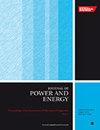Turbine vane endwall aerothermal and film cooling performance considering realistic swirling inflow conditions
IF 1.1
4区 工程技术
Q3 ENGINEERING, MECHANICAL
Proceedings of the Institution of Mechanical Engineers, Part A: Journal of Power and Energy
Pub Date : 2023-06-04
DOI:10.1177/09576509231180421
引用次数: 0
Abstract
The turbine vane inlet downstream of the lean premixed combustor presents nonuniform distributions of velocity and temperature. For obtaining swirling inflow profiles close to reality, the simulated non-reacting combustor is designed firstly. Applying these profiles as inflow boundary conditions, the effects of realistic swirling inflow on the turbine vane endwall aerothermal characteristics and film cooling performance are numerically investigated through solving the three-dimensional Reynolds-Averaged Navier-Stokes equations coupled with the shear stress transfer ([Formula: see text]) turbulence model. Two swirling orientations (anticlockwise and clockwise) and five swirling core pitch-wise positions (aligned with vane 1 to vane 2) are considered in the current work. The results indicate that the residual vortices in the vane passage are strengthened and move with the swirling core along the pitch-wise direction. The migration of the horseshoe vortex is controlled by this movement. The shrinkage or expansion of the separation line of the horseshoe vortex can be observed under the anticlockwise and clockwise swirling inflow conditions respectively. The anticlockwise swirling inflow results in a larger aerodynamic loss by a 10%–35% increase of the laterally [Formula: see text]. The high Nu region near the pressure side surface enlarges and the area-averaged Nu at [Formula: see text] increases from 2337.9 to 2878.3. For the cases with clockwise swirling inflow, the area of the hot ring is enlarged and the Nu downstream of the row 3 film holes is decreased. As for the film cooling performance, the endwall coverage area shrinks and the phantom cooling area enlarges when the anticlockwise swirling core is aligned with vane 2. The endwall loses the protection from the row 3 film holes and the cooling failure ([Formula: see text]) occurs at [Formula: see text] when the swirling core is aligned with the vane passage. This is an extremely bad phenomenon that should be avoided. Among all cases, the highest endwall area-averaged [Formula: see text] (0.122) is obtained when the clockwise swirling core is aligned with vane 1. The largest endwall coverage area is achieved when the clockwise swirling core is aligned with vane 2.考虑实际旋流条件的涡轮叶片端壁气动热和气膜冷却性能
稀薄预混燃烧室下游涡轮叶片入口呈现速度和温度的非均匀分布。为了获得更接近实际的旋流流型,首先设计了模拟非反应燃烧室。将这些剖面作为流入边界条件,通过求解三维reynolds - average Navier-Stokes方程,结合剪切应力传递(公式见文)湍流模型,数值研究了现实涡旋流入对涡轮叶片端壁气动热特性和气膜冷却性能的影响。在目前的工作中,考虑了两个旋转方向(逆时针和顺时针)和五个旋转核心螺距方向位置(与叶片1到叶片2对齐)。结果表明,叶片通道内的残余涡增强,并随旋流芯沿节距方向移动。这种运动控制了马蹄形涡的迁移。在顺时针和逆时针旋流入流条件下,分别观察到马蹄涡分离线的收缩和扩张。逆时针旋流的流入导致了更大的气动损失,横向增加了10%-35%[公式:见文]。靠近压力侧面的高Nu区增大,面积平均Nu在[公式见文]处由2337.9增大到2878.3。顺时针旋流情况下,热环面积增大,第3排膜孔下游的Nu减小。在气膜冷却性能方面,当逆时针旋流芯与叶片2对齐时,端壁覆盖面积缩小,幻象冷却面积增大。端壁失去了对第3排膜孔的保护,当旋心与叶片通道对齐时,冷却失效([公式:见文])发生在[公式:见文]。这是一个非常糟糕的现象,应该避免。在所有情况中,顺时针旋转芯与叶片1对齐时,端壁平均面积最大[公式见文](0.122)。当顺时针旋转的核心与叶片2对齐时,实现了最大的端壁覆盖面积。
本文章由计算机程序翻译,如有差异,请以英文原文为准。
求助全文
约1分钟内获得全文
求助全文
来源期刊

CiteScore
3.30
自引率
5.90%
发文量
114
审稿时长
5.4 months
期刊介绍:
The Journal of Power and Energy, Part A of the Proceedings of the Institution of Mechanical Engineers, is dedicated to publishing peer-reviewed papers of high scientific quality on all aspects of the technology of energy conversion systems.
 求助内容:
求助内容: 应助结果提醒方式:
应助结果提醒方式:


